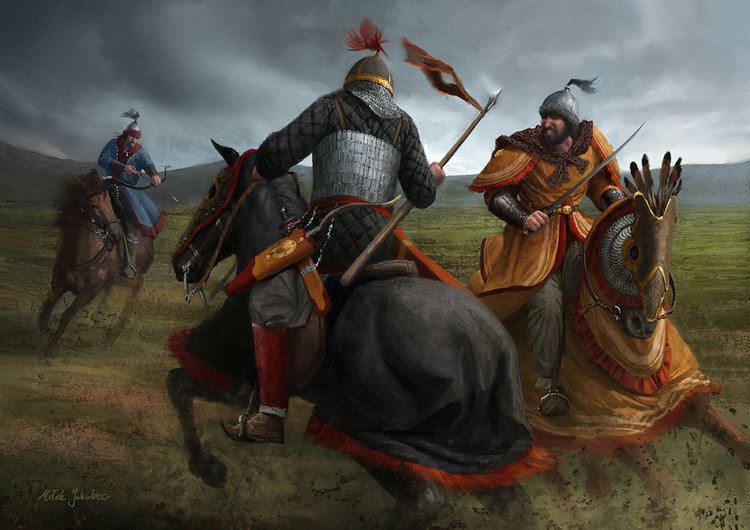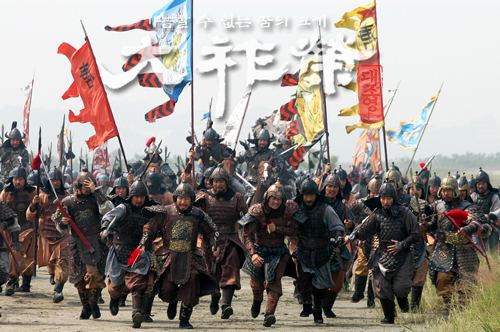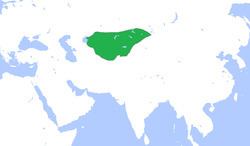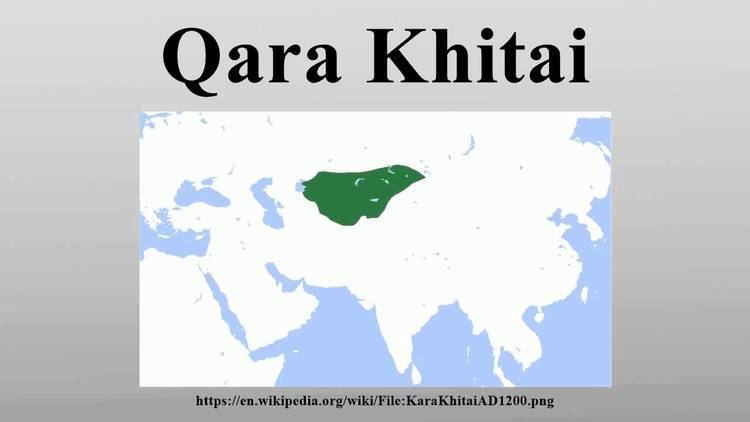Government Monarchy Area 2.5 million km² | 1150–1164 Renzong (Yelü Yilie) Founded 1124 Date dissolved 1218 | |
 | ||
Religion BuddhismChurch of the EastIslam | ||
Qara khitai
The Qara Khitai (alternatively spelled Kara Khitai, Mongolian: Хар Хятан, 1124–1218), also known as the Kara Khitan Khanate or Western Liao (traditional Chinese: 西遼; simplified Chinese: 西辽; pinyin: Xī Liáo), officially the Great Liao (traditional Chinese: 大遼; simplified Chinese: 大辽; pinyin: Dà Liáo), was a sinicized Khitan empire in Central Asia. The dynasty was founded by Yelü Dashi, who led the remnants of the Liao dynasty to Central Asia after fleeing from the Jurchen conquest of their homeland in the north and northeast of modern-day China. The empire was usurped by the Naimans under Kuchlug in 1211; traditional Chinese, Persian, and Arab sources considered the usurpation to be the end of the Qara Khitai rule. The empire was later conquered by the Mongol Empire in 1218.
Contents
- Qara khitai
- Names
- Founding of the Qara Khitai
- Yel Dashis successors
- Kuchlugs usurpation and end of the Khanate
- Aftermath
- Administration
- Association with China
- Legacy
- References

Names

Kara Khitan (Hala Qidan) was the name used by the Khitans to refer to themselves. The phrase is often translated as the Black Khitans in Turkish, but its original meaning is unclear today. In Mongolian, "Kara-Khitan" is rendered "Хар Хятан" (Khar Kidan). Since no direct records from the empire survive today, the only surviving historical records about the empire come from outside sources. The empire took on trappings of a Chinese state, so Chinese historians generally refer to the empire as the Western Liao dynasty, emphasizing its continuation from the Liao dynasty in north and northeast China. Black Khitans (黑契丹) has also been seen used in Chinese (see illustration of "A Qara Khitan man with horse" below). The Jurchens referred to the empire as Dashi or Dashi Linya (after its founder), to reduce any claims the empire may have had to the old territories of the Liao Dynasty. Muslim historians initially referred to the state simply as Khitay or Khitai; they may have adopted this form of "Khitan" via the Uyghurs of Kocho in whose language the final -n or -ń became -y. Only after the Mongol conquest did the state begin to be referred to in the Muslim world as the Kara-Khitai or Qara-Khitai.
Founding of the Qara Khitai

The Qara Khitai empire was established by Yelü Dashi, who led nomadic Khitans west by way of Mongolia after the collapse of the Liao dynasty. The Jurchens, once vassals of the Khitans, had allied with the Song dynasty and overthrown the Liao. Yelü recruited Khitans and other tribes to form an army, and in 1134 captured Balasagun from the Kara-Khanid Khanate, which marks the start of the empire in Central Asia. The Khitan forces were soon joined by 10,000 Khitans, who had been subjects of the Kara-Khanid Khanate. The Khitans then conquered Kashgar, Khotan, and Beshbalik. The Khitans defeated the Western Kara-Khanid Khanate at Khujand in 1137, eventually leading to their control over the Fergana Valley. They won the Battle of Qatwan against the Western Kara-Khanids and the Seljuk Empire on September 9, 1141, which allowed the Khitans to gain control over Transoxiana.
Yelü Dashi's successors

Yelü Dashi died in 1143, and his wife, Xiao Tabuyan, then acted as regent for their son. Their son, Yelü Yiliu, became the ruler in 1150 and died in 1163, to be succeeded by his sister, Yelü Pusuwan. She sent her husband, Xiao Duolubu, on many military campaigns. She then fell in love with his younger brother, Xiao Fuguzhi. They were executed in 1177 by her father-in-law, Xiao Wolila, who then placed Yelü Zhilugu on the throne in 1178. The empire was weakened by rebellions and internal wars among its vassals, especially during the latter parts of its history.
Kuchlug's usurpation and end of the Khanate

In 1208, a Naiman prince, Kuchlug, fled his homeland after being defeated by Mongols. Kuchlug was welcomed into the empire of the Qara-Khitans, and was allowed to marry Zhilugu's daughter. However, in 1211, Kuchlug revolted, and later captured Yelü Zhilugu while the latter was hunting. Zhilugu was allowed to remain as the nominal ruler but died two years later, and many historians regarded his death as the end of the Qara-Khitan empire. In 1216, Genghis Khan dispatched his general Jebe to pursue Kuchlug; Kuchlug fled, but in 1218, he was finally captured and decapitated. The Mongols fully conquered the former territories of the Qara-Khitans in 1220.
Aftermath

The Qara Khitais became absorbed into the Mongol Empire; a segment of the Qara-Khitan troops had previously already joined the Mongol army fighting against Kuchlug. Another segment of the Qara-Khitans, in a dynasty founded by Buraq Hajib, survived in Kirman as a vassal of the Mongols, but ceased to exist as an entity during the reign of Öljaitü of the Ilkhanate. The Qara-Khitans were dispersed widely all over Eurasia as part of the Mongol army. In the 14th century, they began to lose their ethnic identity, traces of their presence however may be found as clan names or toponyms from Afghanistan to Moldova. Today a Khitay tribe still lives in northern Kyrgyzstan.
Administration
The Khitans ruled from their capital at Balasagun (in today's Kyrgyzstan), directly controlling the central region of the empire. The rest of their empire consisted of highly autonomous vassalized states, primarily Khwarezm, the Karluks, the Kingdom of Qocho of the Uyghurs, the Kankali, and the Western, Eastern, and Fergana Kara-Khanids. The late-arriving Naimans also became vassals, before usurping the empire under Kuchlug.
The Khitan rulers adopted many administrative elements from the Liao dynasty, including the use of Confucian administration and imperial trappings. The empire also adopted the title of Gurkhan (universal Khan). The Khitans used the Chinese calendar, maintained Chinese imperial and administrative titles, gave its emperors reign names, used Chinese-styled coins, and sent imperial seals to its vassals. Although most of its administrative titles were derived from Chinese, the empire also adopted local administrative titles, such as tayangyu (Turkic) and vizier.
The Khitans maintained their old customs, even in Central Asia. They remained nomads, adhered to their traditional dress, and maintained the religious practices followed by the Liao dynasty Khitans. The ruling elite tried to maintain the traditional marriages between the Yelü king clan and the Xiao queen clan, and were highly reluctant to allow their princesses to marry outsiders. The Qara-Khitai Khitans followed a mix of Buddhism and traditional Khitan religion, which included fire worship and tribal customs, such as the tradition of sacrificing a gray ox with a white horse. In an innovation unique to the Qara-Khitai, the Khitans paid their soldiers a salary.
The empire ruled over a diverse population that was quite different from its rulers. The majority of the population was sedentary, although the population suddenly became more nomadic during the end of the empire, due to the influx of Naimans. The majority of their subjects were Muslims, although a significant minority practiced Buddhism and Nestorianism. Although Chinese and Khitan were the primary languages of administration, the empire also administered in Persian and Uyghur.
Association with China
After the Tang dynasty, non-Han Chinese empires gained prestige by connecting themselves with China, and the Khitan Gurkans used the title of Chinese emperor, and was also called the Khan of Chīn. The Qara Khitai used the "image of China" to legitimize their ruler to the Central Asian Muslims. The Chinese emperor, together with the rulers of the Turks, Arabs, India and Byzantium, were known to Islamic writers as the world's "five great kings". The Khitan Qara-Khitai empire in Central Asia kept the trappings of a Chinese state, such as Chinese coins, the Chinese writing system, tablets, seals, and used Chinese products like porcelein, mirrors, jade and other Chinese customs. The adherence to Liao Chinese traditions has been suggested as a reason why the Qara Khitai did not convert to Islam. Despite the Chinese trappings, there were comparatively few Han Chinese among the population of the Qara Khitan. These Han Chinese had lived in Kedun during the Liao dynasty, and in 1124 migrated with the Khitans under Yelü Dashi along with other people of Kedun, such as Bohai, Jurchen, Mongol tribes, Khitan, in addition to the Xiao consort clan.
Qara Khitai's rule over Muslim Central Asia has the effect of reinforcing the view among some Muslim writers that Central Asia was linked to China a few hundred years after the Tang dynasty had lost control of the region. Marwazī wrote that Transoxania was a former part of China, while Fakhr al-Dīn Mubārak Shāh defined China as part of "Turkestan", and the cities of Balāsāghūn and Kashghar were considered part of China.
Legacy
The association of Khitai with China meant that the most enduring trace of the Khitan's power is names that are derived from it, such as Cathay, which is the medieval Latin appellation for China. Names derived from Khitai are still current in modern usage, such as the Russian, Bulgarian, Uzbek and Mongolian names for China. However, the use of the name Khitai to mean "China" or "Chinese" by Turkic speakers within China, such as the Uyghurs, is considered pejorative by the Chinese authorities, who tried to ban it.
